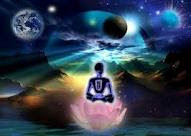DHARMA (Righteousness)
The Brihadaranyaka Upanishad views dharma as the Universal principle of law, order, harmony, all is all truth, that sprang first from Brahman.
Dharma is not just law, or harmony, it is pure Reality.
ARTHA (Livelihood, wealth)
Artha is objective and virtuous pursuit of wealth for livelihood, obligations and economic prosperity. It is inclusive of political life, diplomacy and material well-being. The doctorine of Artha is called Arthashastra.
KAMA (Sensual pleasure)
MOKSHA (Liberation, freedom from samsara)
Moksha literally means " release" is the last goal of life. It is liberation from samsara and the concomitant suffering involved in being subject to the cycle of repeated death and re-incarnation.
YOGA
Paths that one can follow to achieve the spiritual goal of life include:-
(a) Bhakti Yoga (the path of love and affection)
(b) Karma Yoga (the path of right action)
(c) Raja Yoga (the path of meditation)
(d) Jnana Yoga (the path of wisdom)
SCRIPTURES
The sciptures were transmitted orally in verse from to aid memorization, for many centuries before they were written down. The texts are classified into two classes: Shruti and Smriti
SHRUTI
It refers to Vedas, which form the earliest record of hindu scriptures.
There are four Vedas (Rig, Sama, Yajur and Atharva).
Each Veda is divided into four parts: the primary one, the Veda proper, being the Samhita which contains sacred mantras.
The other three-tier ensemble of commentaries are Brahmanas, Aranyakas & Upanishads.
Samhita and Brahmanas are called the Karmakanda (ritualistic portion), while the last two form the Jnanakanda (knowledge portion).
SMRITIS
Hindu texts other than the shruti are collectively called the Smriti (memory).
Most notable of the smritis are the epics, Mahabharata & Ramayana.
Bhagavad Gita is an integral part of Mahabharta and one of the most popular sacred texts of Hinduism.
It contains philosophical teachings from Krishna (an incarnation of Vishnu).
Puranas which illustrate Hindu ideas through vivid narratives come under smritis.
SHRUTI
It refers to Vedas, which form the earliest record of hindu scriptures.
There are four Vedas (Rig, Sama, Yajur and Atharva).
Each Veda is divided into four parts: the primary one, the Veda proper, being the Samhita which contains sacred mantras.
The other three-tier ensemble of commentaries are Brahmanas, Aranyakas & Upanishads.
Samhita and Brahmanas are called the Karmakanda (ritualistic portion), while the last two form the Jnanakanda (knowledge portion).
SMRITIS
Hindu texts other than the shruti are collectively called the Smriti (memory).
Most notable of the smritis are the epics, Mahabharata & Ramayana.
Bhagavad Gita is an integral part of Mahabharta and one of the most popular sacred texts of Hinduism.
It contains philosophical teachings from Krishna (an incarnation of Vishnu).
Puranas which illustrate Hindu ideas through vivid narratives come under smritis.
















